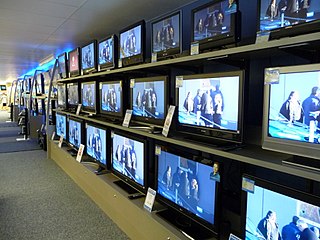
Television (TV) is a telecommunication medium for transmitting moving images and sound. The term can refer to a television set, or the medium of television transmission. Television is a mass medium for advertising, entertainment, news, and sports.

An LCD projector is a type of video projector for displaying video, images or computer data on a screen or other flat surface. It is a modern equivalent of the slide projector or overhead projector. To display images, LCD projectors typically send light from a metal-halide lamp through a prism or series of dichroic filters that separates light to three polysilicon panels – one each for the red, green and blue components of the video signal. As polarized light passes through the panels, individual pixels can be opened to allow light to pass or closed to block the light. The combination of open and closed pixels can produce a wide range of colors and shades in the projected image.

Digital Light Processing (DLP) is a set of chipsets based on optical micro-electro-mechanical technology that uses a digital micromirror device. It was originally developed in 1987 by Larry Hornbeck of Texas Instruments. While the DLP imaging device was invented by Texas Instruments, the first DLP-based projector was introduced by Digital Projection Ltd in 1997. Digital Projection and Texas Instruments were both awarded Emmy Awards in 1998 for the DLP projector technology. DLP is used in a variety of display applications from traditional static displays to interactive displays and also non-traditional embedded applications including medical, security, and industrial uses.
Trans-Lux is a company that specializes in designing, selling, leasing, and maintaining multi-color, real-time data and LED large-screen electronic information displays, but is primarily known as a major supplier of national stock ticker displays for stock exchanges. These indoor and outdoor displays are used worldwide in many industries, including banking, gaming, corporate, retail, healthcare, sports, transportation and in the financial industry.
Out-of-home (OOH) advertising, also called outdoor advertising, outdoor media, and out-of-home media, is advertising experienced outside of the home. This includes billboards, wallscapes, and posters seen while "on the go". It also includes place-based media seen in places such as convenience stores, medical centers, salons, and other brick-and-mortar venues. OOH advertising formats fall into four main categories: billboards, street furniture, transit, and alternative.

A handheld projector is an image projector in a handheld device. It was developed as a computer display device for compact portable devices such as mobile phones, personal digital assistants, and digital cameras, which have sufficient storage capacity to handle presentation materials but are too small to accommodate a display screen that an audience can see easily. Handheld projectors involve miniaturized hardware, and software that can project digital images onto a nearby viewing surface.

An active shutter 3D system is a technique of displaying stereoscopic 3D images. It works by only presenting the image intended for the left eye while blocking the right eye's view, then presenting the right-eye image while blocking the left eye, and repeating this so rapidly that the interruptions do not interfere with the perceived fusion of the two images into a single 3D image.

Digital signage is a segment of electronic signage. Digital displays use technologies such as LCD, LED, projection and e-paper to display digital images, video, web pages, weather data, restaurant menus, or text. They can be found in public spaces, transportation systems, museums, stadiums, retail stores, hotels, restaurants and corporate buildings etc., to provide wayfinding, exhibitions, marketing and outdoor advertising. They are used as a network of electronic displays that are centrally managed and individually addressable for the display of text, animated or video messages for advertising, information, entertainment and merchandising to targeted audiences.
The Technology and Engineering Emmy Awards, or Technology and Engineering Emmys, are one of two sets of Emmy Awards that are presented for outstanding achievement in engineering development in the television industry. The Technology and Engineering Emmy Awards are presented by the National Academy of Television Arts and Sciences (NATAS), while the separate Primetime Engineering Emmy Awards are given by its sister organization the Academy of Television Arts & Sciences (ATAS).

1st & Ten is a computer system that augments televised coverage of American football by inserting graphical elements on the field of play as if they were physically present; the inserted element stays fixed within the coordinates of the playing field and obeys the visual rules of foreground objects occluding background objects. Developed by Sportvision and PVI Virtual Media Services, it is best known for generating and displaying a yellow first down line over a live broadcast of a football game—making it easier for viewers to follow play on the field. The line is not physically present on the field and is seen only by the television audience.

Signage is the design or use of signs and symbols to communicate a message. Signage also means signs collectively or being considered as a group. The term signage is documented to have been popularized in 1975 to 1980.

Konka Group Co., Ltd. is a Chinese manufacturer of electronics products headquartered in Shenzhen, Guangdong and listed on Shenzhen Stock Exchange.
Ronald Nicholas Andruff is a Canadian former professional ice hockey player.
Fulldome refers to immersive dome-based video display environments. The dome, horizontal or tilted, is filled with real-time (interactive) or pre-rendered (linear) computer animations, live capture images, or composited environments.

A video wall is a special multi-monitor setup that consists of multiple computer monitors, video projectors, or television sets tiled together contiguously or overlapped in order to form one large screen. Typical display technologies include LCD panels, Direct View LED arrays, blended projection screens, Laser Phosphor Displays, and rear projection cubes. Jumbotron technology was also previously used. Diamond Vision was historically similar to Jumbotron in that they both used cathode-ray tube (CRT) technology, but with slight differences between the two. Early Diamond vision displays used separate flood gun CRTs, one per subpixel. Later Diamond vision displays and all Jumbotrons used field-replaceable modules containing several flood gun CRTs each, one per subpixel, that had common connections shared across all CRTs in a module; the module was connected through a single weather-sealed connector.
Sony Depthsensing Solutions SA/NV, formerly known as SoftKinetic Systems, is a Belgian company originating from the merger of Optrima NV, founded by André Miodezky, Maarten Kuijk, Daniël Van Nieuwenhove, Ward Van der Tempel and Tomas Van den Hauwe and SoftKinetic SA founded by Eric Krzeslo, Thibaud Remacle, Gilles Pinault and Xavier Baele. Sony Depthsensing Solutions develops gesture recognition hardware and software for real-time range imaging (3D) cameras. SoftKinetic was founded in July 2007 providing gesture recognition solutions based on its technology to the interactive digital entertainment, consumer electronics, health & fitness, and serious game industries. SoftKinetic technology has been applied to interactive digital signage and advergaming, interactive television, and physical therapy.
GestureTek is an American-based interactive technology company headquartered in Silicon Valley, California, with offices in Toronto and Ottawa, Ontario and Asia.
PVI Virtual Media Services is one of the companies behind the virtual yellow-down-line shown on television broadcasts of American football games in the United States and Canada. Founded in 1990 as Princeton Electronic Billboard, PVI Virtual Media Services was a wholly owned subsidiary of Cablevision Systems Corporation with a research and operations facility in Lawrenceville, NJ before being acquired by ESPN in December, 2010.
Virtual advertising is the use of digital technology to insert virtual advertising content into a live or pre-recorded television show, often in sports events. This technique is often used to allow broadcasters to overlay existing physical advertising panels with virtual content on the screen when broadcasting the same event in multiple regions; a Spanish football game will be broadcast in Mexico with Mexican advertising images. Similarly, virtual content can be inserted onto empty space within the sports venue such as the field of play, where physical advertising cannot be placed due to regulatory or safety reasons. Virtual advertising content is intended to be photo-realistic, so that the viewer has the impression they are seeing the real in-stadium advertising.









